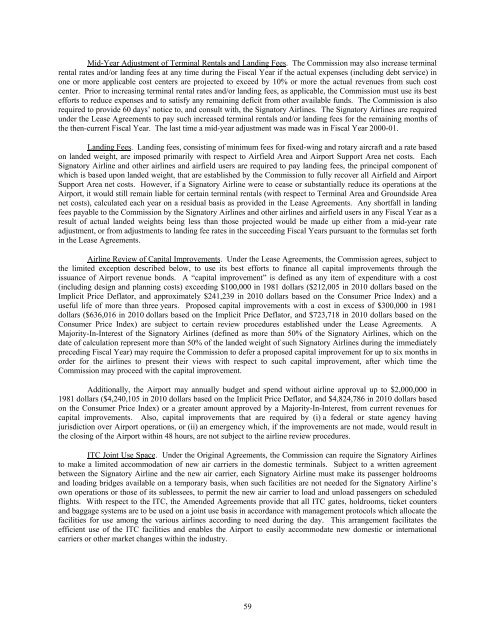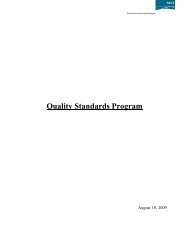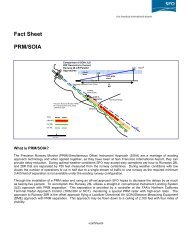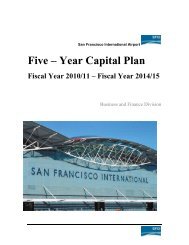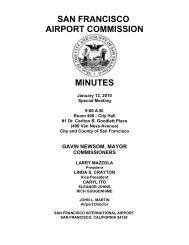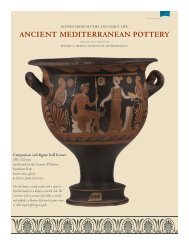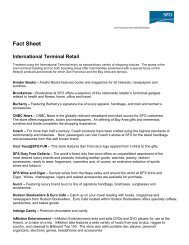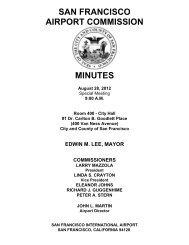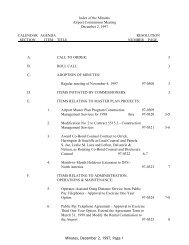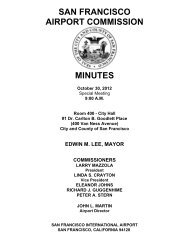Official Statement Airport Commission City and County of San ...
Official Statement Airport Commission City and County of San ...
Official Statement Airport Commission City and County of San ...
You also want an ePaper? Increase the reach of your titles
YUMPU automatically turns print PDFs into web optimized ePapers that Google loves.
Mid-Year Adjustment <strong>of</strong> Terminal Rentals <strong>and</strong> L<strong>and</strong>ing Fees. The <strong>Commission</strong> may also increase terminal<br />
rental rates <strong>and</strong>/or l<strong>and</strong>ing fees at any time during the Fiscal Year if the actual expenses (including debt service) in<br />
one or more applicable cost centers are projected to exceed by 10% or more the actual revenues from such cost<br />
center. Prior to increasing terminal rental rates <strong>and</strong>/or l<strong>and</strong>ing fees, as applicable, the <strong>Commission</strong> must use its best<br />
efforts to reduce expenses <strong>and</strong> to satisfy any remaining deficit from other available funds. The <strong>Commission</strong> is also<br />
required to provide 60 days’ notice to, <strong>and</strong> consult with, the Signatory Airlines. The Signatory Airlines are required<br />
under the Lease Agreements to pay such increased terminal rentals <strong>and</strong>/or l<strong>and</strong>ing fees for the remaining months <strong>of</strong><br />
the then-current Fiscal Year. The last time a mid-year adjustment was made was in Fiscal Year 2000-01.<br />
L<strong>and</strong>ing Fees. L<strong>and</strong>ing fees, consisting <strong>of</strong> minimum fees for fixed-wing <strong>and</strong> rotary aircraft <strong>and</strong> a rate based<br />
on l<strong>and</strong>ed weight, are imposed primarily with respect to Airfield Area <strong>and</strong> <strong>Airport</strong> Support Area net costs. Each<br />
Signatory Airline <strong>and</strong> other airlines <strong>and</strong> airfield users are required to pay l<strong>and</strong>ing fees, the principal component <strong>of</strong><br />
which is based upon l<strong>and</strong>ed weight, that are established by the <strong>Commission</strong> to fully recover all Airfield <strong>and</strong> <strong>Airport</strong><br />
Support Area net costs. However, if a Signatory Airline were to cease or substantially reduce its operations at the<br />
<strong>Airport</strong>, it would still remain liable for certain terminal rentals (with respect to Terminal Area <strong>and</strong> Groundside Area<br />
net costs), calculated each year on a residual basis as provided in the Lease Agreements. Any shortfall in l<strong>and</strong>ing<br />
fees payable to the <strong>Commission</strong> by the Signatory Airlines <strong>and</strong> other airlines <strong>and</strong> airfield users in any Fiscal Year as a<br />
result <strong>of</strong> actual l<strong>and</strong>ed weights being less than those projected would be made up either from a mid-year rate<br />
adjustment, or from adjustments to l<strong>and</strong>ing fee rates in the succeeding Fiscal Years pursuant to the formulas set forth<br />
in the Lease Agreements.<br />
Airline Review <strong>of</strong> Capital Improvements. Under the Lease Agreements, the <strong>Commission</strong> agrees, subject to<br />
the limited exception described below, to use its best efforts to finance all capital improvements through the<br />
issuance <strong>of</strong> <strong>Airport</strong> revenue bonds. A “capital improvement” is defined as any item <strong>of</strong> expenditure with a cost<br />
(including design <strong>and</strong> planning costs) exceeding $100,000 in 1981 dollars ($212,005 in 2010 dollars based on the<br />
Implicit Price Deflator, <strong>and</strong> approximately $241,239 in 2010 dollars based on the Consumer Price Index) <strong>and</strong> a<br />
useful life <strong>of</strong> more than three years. Proposed capital improvements with a cost in excess <strong>of</strong> $300,000 in 1981<br />
dollars ($636,016 in 2010 dollars based on the Implicit Price Deflator, <strong>and</strong> $723,718 in 2010 dollars based on the<br />
Consumer Price Index) are subject to certain review procedures established under the Lease Agreements. A<br />
Majority-In-Interest <strong>of</strong> the Signatory Airlines (defined as more than 50% <strong>of</strong> the Signatory Airlines, which on the<br />
date <strong>of</strong> calculation represent more than 50% <strong>of</strong> the l<strong>and</strong>ed weight <strong>of</strong> such Signatory Airlines during the immediately<br />
preceding Fiscal Year) may require the <strong>Commission</strong> to defer a proposed capital improvement for up to six months in<br />
order for the airlines to present their views with respect to such capital improvement, after which time the<br />
<strong>Commission</strong> may proceed with the capital improvement.<br />
Additionally, the <strong>Airport</strong> may annually budget <strong>and</strong> spend without airline approval up to $2,000,000 in<br />
1981 dollars ($4,240,105 in 2010 dollars based on the Implicit Price Deflator, <strong>and</strong> $4,824,786 in 2010 dollars based<br />
on the Consumer Price Index) or a greater amount approved by a Majority-In-Interest, from current revenues for<br />
capital improvements. Also, capital improvements that are required by (i) a federal or state agency having<br />
jurisdiction over <strong>Airport</strong> operations, or (ii) an emergency which, if the improvements are not made, would result in<br />
the closing <strong>of</strong> the <strong>Airport</strong> within 48 hours, are not subject to the airline review procedures.<br />
ITC Joint Use Space. Under the Original Agreements, the <strong>Commission</strong> can require the Signatory Airlines<br />
to make a limited accommodation <strong>of</strong> new air carriers in the domestic terminals. Subject to a written agreement<br />
between the Signatory Airline <strong>and</strong> the new air carrier, each Signatory Airline must make its passenger holdrooms<br />
<strong>and</strong> loading bridges available on a temporary basis, when such facilities are not needed for the Signatory Airline’s<br />
own operations or those <strong>of</strong> its sublessees, to permit the new air carrier to load <strong>and</strong> unload passengers on scheduled<br />
flights. With respect to the ITC, the Amended Agreements provide that all ITC gates, holdrooms, ticket counters<br />
<strong>and</strong> baggage systems are to be used on a joint use basis in accordance with management protocols which allocate the<br />
facilities for use among the various airlines according to need during the day. This arrangement facilitates the<br />
efficient use <strong>of</strong> the ITC facilities <strong>and</strong> enables the <strong>Airport</strong> to easily accommodate new domestic or international<br />
carriers or other market changes within the industry.<br />
59


